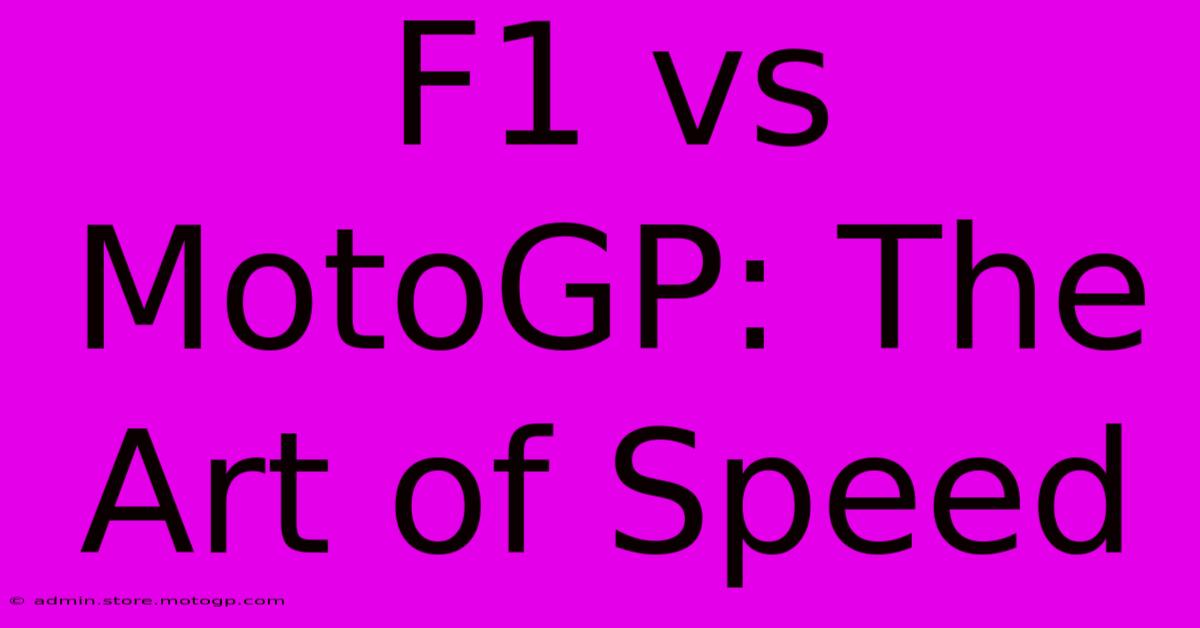F1 Vs MotoGP: The Art Of Speed

Table of Contents
F1 vs MotoGP: The Art of Speed – A Head-to-Head Comparison
The roar of the engines, the smell of burning rubber, the breathtaking speeds – motorsport offers a thrilling spectacle. But when it comes to the ultimate test of speed and skill, two giants reign supreme: Formula 1 and MotoGP. Both disciplines demand incredible precision, daring, and unwavering focus, but their approaches to achieving speed are vastly different. This article dives deep into the captivating world of F1 and MotoGP, comparing their unique characteristics and exploring which reigns supreme in the art of speed.
The Machines: A Tale of Two Wheels and Four
The most obvious difference lies in the machinery itself. Formula 1 cars are technological marvels, four-wheeled beasts boasting sophisticated aerodynamics, powerful hybrid engines, and advanced electronics. Their speed is primarily derived from powerful downforce, allowing them to corner at incredible speeds, generating speeds exceeding 200 mph on straights. Think of them as sleek, powerful predators, optimized for high-speed cornering and raw power.
MotoGP bikes, on the other hand, are lean, mean, two-wheeled machines. While lacking the downforce of an F1 car, they compensate with nimble handling and incredible acceleration. Riders must constantly wrestle with the bike’s power and lean angle, making for a much more physical and demanding experience. Their speed comes from a potent combination of lightweight design, exceptional cornering ability, and ferocious acceleration out of bends. They're agile and responsive, demanding absolute precision from their riders.
Key Differences in Technology:
- Aerodynamics: F1 cars utilize extensive aerodynamic elements to generate downforce, allowing them to corner at higher speeds. MotoGP bikes rely on rider skill and lean angle for cornering.
- Engine Power: F1 cars utilize powerful hybrid engines, whereas MotoGP bikes use high-revving, powerful internal combustion engines.
- Weight: F1 cars are significantly heavier than MotoGP bikes, impacting acceleration and handling.
- Tire Technology: Both disciplines use specialized tires, but the demands on MotoGP tires are significantly higher due to the bike's lean angles and acceleration forces.
The Riders: Masters of Control and Precision
The drivers and riders themselves are the heart of both sports. F1 drivers need exceptional car control, strategic awareness, and the ability to manage tire wear and fuel consumption over long races. It’s a battle of precision and strategic thinking.
MotoGP riders display an unparalleled level of physical fitness, balance, and reflexes. They experience incredible G-forces during cornering, demanding immense stamina and core strength. It’s a raw display of human skill against the unforgiving forces of nature. They’re true masters of control.
Skill Comparisons:
- Physicality: MotoGP requires significantly more physical strength and stamina than F1.
- Precision: Both require exceptional precision, but the tolerances in MotoGP are arguably tighter.
- Strategic Thinking: F1 drivers rely more heavily on strategic thinking and race management.
- Reaction Time: Both require lightning-fast reaction times, but the demands are different due to the nature of the machines.
The Tracks: Different Challenges, Similar Thrills
The circuits themselves present different challenges. F1 tracks are typically faster and wider, prioritizing high-speed cornering and long straights. The emphasis is on speed and overtaking opportunities.
MotoGP tracks tend to be more technical and narrower, demanding precise line choices and impeccable braking points. These are often tighter, twisty circuits, rewarding skill and finesse over outright speed.
Track Differences:
- Track Width: F1 tracks are generally wider, allowing for more overtaking opportunities.
- Corner Types: MotoGP tracks feature a higher proportion of tighter, more technical corners.
- Track Length: The lengths of tracks are variable for both.
The Verdict: Which Reigns Supreme?
Declaring a definitive winner in the "art of speed" debate between F1 and MotoGP is subjective. Both offer breathtaking displays of speed, skill, and technological prowess. F1 showcases the pinnacle of automotive engineering and strategic racing, while MotoGP highlights the incredible skill and physical prowess of human beings against powerful machinery. Ultimately, the "best" is a matter of personal preference. Both sports deserve their accolades and captivated audiences worldwide with their unique approaches to achieving the ultimate speed.

Thank you for visiting our website wich cover about F1 Vs MotoGP: The Art Of Speed. We hope the information provided has been useful to you. Feel free to contact us if you have any questions or need further assistance. See you next time and dont miss to bookmark.
Featured Posts
-
Experience The Energy Electrifying Moto Gp Pictures
Feb 21, 2025
-
The Passion Of Racing Best Motorcycle Racing Blogs
Feb 21, 2025
-
Level Up Your Driving Cota Open Track Days
Feb 21, 2025
-
The Moto Gp Goat Separating Myth From Reality
Feb 21, 2025
-
Ultimate Cota Transportation Guide For 2024
Feb 21, 2025
